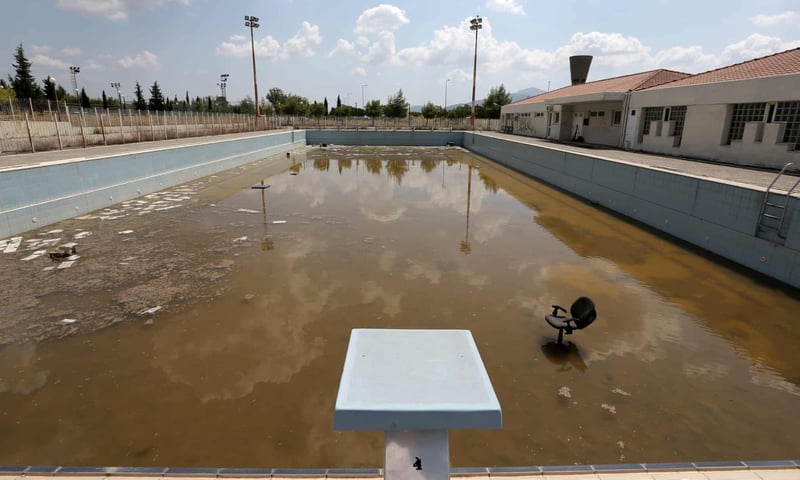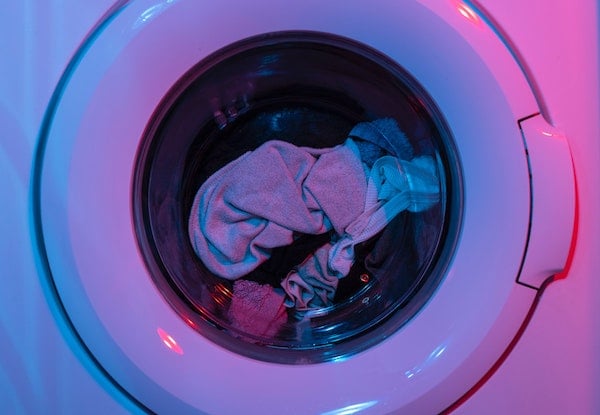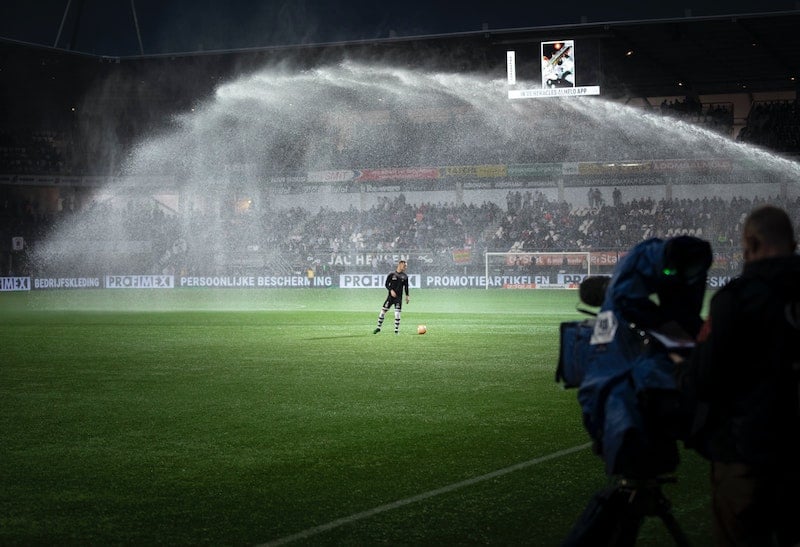Times are changing.
We are undergoing a period of reflection, in which society is being called into question through a growing awareness of how climate and environmental issues are affecting our lives. Not just our ordinary lives as citizens, but also as sportsmen and women, athletes, supporters, and consumers; and as brands, institutions, organisations, and media.
Before going into the effects of climate change on our sports activities (as recently outlined by WWF France), let's turn the question around: What are the effects of our sports activities on the environment in the medium and long term?
The impact of sport on climate change
Sport is one of the most dynamic sectors in the world, largely because of its popularity: It influences several million people every day. So, no wonder it has an impact on the environment. Consider the two most popular worldwide sporting events: the Olympic and Paralympic Games and the FIFA World Cup. They have significant and lasting economic and environmental impacts that endure for decades.
From the construction of infrastructures for high-level sport to the movement of athletes and mass-movements of their supporters – not to mention textiles –, the sports industry has a considerable carbon footprint and uses a massive amount of the planet's resources. Let's go into some detail ⤵︎
Organisation of sporting events
When you start exploring the matter of sports' environmental impact, the most obvious element to consider is undoubtedly sporting events. Their impact is felt before, during and after.
The impact of sporting events, during
During the event, the impact is limited because it's a one-off and the timespan is relatively short: Aside from the Olympics, the World Cup and the big cycling races such as the Tour de France or the Giro, sports events generally only last a few hours or days. The main culprits: Waste management and mobility. In figures:
- An event of 5,000 people alone generates up to 2.5 tonnes of waste.
- It is estimated that 90% of Roland Garros' carbon footprint comes from the movement of the spectators attending the tournament.
- In 2018, 5 million supporters travelled to Russia to support their football team.
- 85% of the greenhouse gas emissions from a sporting event such as a UEFA EURO are due to the travel and accommodation of millions of people. This represents around 1.6 million tons of CO2 (equivalent to the annual emissions of half a million households).
The impact of sporting events, before and after
Before the event, the environmental impact is largely down to the construction of sports facilities, so great that the substantial human impact shrinks by comparison. After the event, the environmental impact quite simply correlates with the use of these same sports facilities: the notorious legacy.
Does the term "white elephant" ring any bells? A white elephant is a possession (often a large-scale, prestigious construction) which its owner cannot dispose of and whose cost, particularly that of maintenance, is out of proportion to its usefulness. (Wikipedia) In other words, a financial burden. For example, after the Football World Cup organised in Brazil in 2014, the brand new Manaus stadium in the middle of the Amazon (4 years of construction, capacity of 40,000 spectators, 205 million euros) was completely abandoned as soon the event ended. The Rio Olympics are another example, with the stadiums and swimming pools that were already obsolete by the time the event took place; or the 2004 Athens Olympics, whose constructions have remained abandoned for over fifteen years (check the photos in this Guardian article).
 An abandoned training pool for athletes at the Olympic Village - Athens
An abandoned training pool for athletes at the Olympic Village - Athens
Photograph: Thanassis Stavrakis/AP
A far cry from the (rightly) controversial Sochi Olympics, Paris 2024 already shows signs of commendable ambition, displayed from the very start of its candidacy. The aim is for 95% of the infrastructures it uses to be already existing or temporary, while halving the emissions produced by the Games and compensating for these emissions.
"Faced with humanity's greatest challenge, Paris 2024, organiser of the world's biggest event, is shouldering its responsibilities. The Paris 2024 Games will be unprecedented because they'll be both spectacular and sustainable. With temperance, innovation, and daring, we're inventing new ways of doing things and launching a new era in the organisation of the Olympic and Paralympic Games." - Paris 2024
Management of sports infrastructure
The massive use of resources is not limited to the mere construction of sports infrastructure. Keeping these infrastructures operative also means maintaining them on a daily basis, which requires a lot of resources. To demonstrate this, here are three examples.
Skiing
Skiing tops the list of most polluting sports. While the greater proportion of this activity's ecological impact is caused by the movements (60%) and accommodation (35%) of the practitioners, ski resorts also have an impact. In fact, 95% of their carbon footprint is directly linked to grooming the slopes. Then there are the snow cannons, used with ever more frequency as global warming increases and the snowpack diminishes: To produce a hectare of snow, you need enough water to fill an Olympic swimming pool. Let's not even mention the destructive impact ski resorts have on biodiversity.
Golf
Do you know how many golf courses there are on the planet?

35,000!
The maintenance these require makes golf one of the most polluting and energy-consuming sports. First, because we rely heavily on pesticides and fertilisers to obtain a perfect lawn. It is estimated that 18 kg of pesticides are used per hectare per year – by way of comparison, agriculture uses 2.5 kg per hectare per year. But above all: 9.5 billion litres of water are used every day in the world to water golf course lawns. This massive consumption of water also creates economic and ecological tensions in certain regions (such as California). While initiatives for more sustainable golf practices have emerged, they remain largely in the wings: examples include the use of artificial lawns, grass that consumes less water, and the optimisation of automatic sprinklers.
Football
Grass again, but now we're talking about football stadium lawns. The majority are natural grass and maintaining them is not only very expensive but also harmful. In France, to maintain 30,000 football fields, it's estimated that clubs consume over 100,000 million cubic meters of water – equivalent to the annual consumption of 2 million French people. Again, we rely on pesticides and fungicides that pollute the soil and give rise to greenhouse gas emissions. But here too, there are alternatives. One example is AS Monaco (Ligue 1, France) which has massively reduced its use of insecticides and fungicides as well as its water consumption.
Sports textile industry
Part of sports' ecological impact is down to the clothes we wear. The manufacture of shoes and clothing is deemed responsible for 10% of greenhouse gas emissions – that's more than maritime and air traffic combined. Let's take a close look at this, from manufacture to use.
Energy-intensive manufacturing
80% of the textile industry's environmental impact is due to production. It is the second most water-consuming sector in the world, especially with regard to cotton. Here's a figure to remember: the sector consumes around 79 billion cubic metres of water each year. Meanwhile, 2.7 million people live without access to water.
With regard to sports-related clothing, the main protagonist is not cotton, which consumes a lot of water, but polyester and polyamides. Manufacturers tend to choose these textiles for their breathability, elasticity, and better anti-perspiration qualities – and, also, because they're cheap. Why is this a problem for the environment? These synthetic materials come from fossil materials: unsustainable and extremely polluting.
Take polyester: 55% of the clothing produced in the world (and not just for sports) is made from it. It is a fibre obtained from petrochemicals, a kind of plastic, therefore oil. Obtaining petrochemicals involves a highly water- and energy-intensive process that requires 70 million barrels of oil each year, the equivalent of 21,000 swimming pools.
What about polyamides? We're mainly talking about nylon here, which accounts for 9% of manufactured fabrics. Like polyester, nylon comes from petrochemicals (petroleum) and poses the same environmental problems. Its manufacturing process is extremely polluting: Producing nylon creates nitrogen oxide or nitrous oxide (N2O), a greenhouse gas 300 times more powerful (i.e., more "warming") than CO2.
If you want to find out more about the impact of manufacturing sports textiles, we recommend this article.
Polluting use
The textile industry is second on the list of industries causing the greatest microplastic pollution. It's not just the manufacturing process that causes this kind of pollution...
After a good workout, you head to the washing machine. But: washing your bra and leggings is not as innocent an activity as it seems if they contain polyester and polyamides.

With each wash, 9 million micro-plastics travel from the washing machine, through wastewater treatment plants, to end up in the ocean. Invisible to the naked eye, these micro particles are not without effect on our environment and on marine animals, who ingest them without being able to digest them (the particles then remain lodged in their flesh). In total, 500,000 tonnes of microplastics are released into the ocean each year via our washing machines, the equivalent of 50 billion plastic bottles.
To find out more, take a look at this detailed report published by Greenpeace that investigates football sportswear.
So yes, it all sounds very bleak. Fortunately, things are changing! Driven by more informed consumers, brands specialising in sports are gradually becoming aware of their ecological impact and are getting ready to offer more environmentally friendly alternatives (such as natural or recycled fibres). Merrell, Patagonia, and Girlfriend Collective are good examples of this, to name but a few of the companies who've made this subject a priority. Sportswear giants like Adidas and Nike are also joining in, and are committed to reducing their environmental impact, especially in terms of plastic pollution.
While this list is far from exhaustive, it serves to illustrate that the practice of sport also plays its part in global warming. Between massive use of the planet's resources and pollution of the soil and the oceans, the sports industry can and must avoid damaging the planet, reduce its impact, or compensate for it.
Since the sports that bring our lives into tempo also beat out their rhythm for the planet, it's time to find new solutions and develop the alternatives that already exist, if we are to protect our one and only playground.
Because the impact of climate change on sport is already being felt.
The impact of climate change on sport
Like any other human activity, sport is going to be directly impacted by the consequences of climate change. Right across the board. Amateurs, high-level athletes, organisers, institutions, countries – all will have to adapt.
To tell you about climate change and its impact on the activities of athletes, we sourced our information from the report published in 2021 by our partner, WWF France, “Dérèglement climatique : le monde du sport à +2°C et +4°C” ('Climate change: The world of sport at +2°C and +4°C'). The conclusion is alarming: Climate change could cause the loss of up to two months of sports activity per year.
"As sportsmen and women, we also depend on natural elements that are likely to change to a greater or lesser degree depending on the levels of climatic disturbance; we therefore depend on the decisions taken to contain this disturbance and adapt to it. What's a skier without snow? Who's going to play rugby or run a marathon at 40 or 45 degrees? [...] The climate doesn't just influence performance – it affects the practice of sport itself." - Isabelle Autissier, Honorary President of WWF France
What would become of sports in a world at +2°C and +4°C?
In its report, WWF France chooses to focus on two scenarios well-documented by scientists, in particular by the IPCC:
- The scenario favoured by the 2015, Paris Agreement, is a world with an average temperature of 2°C above pre-industrial levels (1850-1900);
- The disaster scenario, which is probable nonetheless, is a world averaging + 4°C above pre-industrial levels.
Note that this report mainly focuses on the practice of sport in France.
The consequences of global warming on outdoor sports activities
The last three decades have been the hottest since 1850, with ever more intense and frequent heat waves. This acceleration is set to continue, with a key forecast: the frequency of heat waves is predicted to double by 2050.
These frequent and successive heat waves would endanger the health of sportsmen and women (sport is not recommended above 32°C) and would disrupt all sports activities (organised and individual). According to the WWF France report, in a world at +2°C, sports practitioners could forfeit up to 24 days of practice. Even up to 66 days, in a world at +4°C.
What about competitions? Remember the 2014 Australian Open? With temperatures of over 41°C, tennis players basically roasted on the courts! In the future, such heat would impact more and more sports competitions, posing serious health risks for athletes. Heat stroke, abnormal fatigue, discomfort, etc.

Beyond health, it would also be a big blow to performance. It's estimated that the ideal temperature for sports involving high-intensity effort over a short period (sprint) is 23°C, and 10°C for prolonged efforts (marathon). Does this spell the end for records?
The consequences of global warming on water sports
Surfing, open-water swimming, sailing… These activities depend entirely on environmental and meteorological conditions.
As the sea level rises due to melting ice and oceans warm, we are witnessing the acceleration of two phenomena: Coastal erosion and flooding. What are the consequences? Over the last 50 years, in France, 30 square kilometres (equivalent to 4,200 football fields) of land surface have already disappeared. And that's just the beginning. In a world of + 4°C, the sea level could rise another metre or more.
This won't fail to have an impact on nautical sports such as sailing. For practitioners: Increased risk of heat stroke and drowning. For organisations: A very large proportion of French sailing clubs would be threatened by damage to infrastructure, or even their loss (1/7 are located on the coast).
The consequences of global warming on indoor sports activities
Indoor activities would also be impacted by global warming (both at +2°C and +4°C): Heat waves are a threat for sports halls, half of which are not built to sustain heat waves. This will make them less and less accessible.
It is a climatic challenge for communities, who very often are those in charge of sports halls that host sporting events of all levels. There is only one solution: To adapt and renovate by taking into climate changes into account, not just in the present but also in the future.
The consequences of global warming on sports activities in stadiums
The condition of the pitch is vital to the success of a match; the players' performance depends on it, as does their safety. The grass on the pitch absorbs shocks, protecting the players' joints. That's why so much effort goes into this lawn.
Regardless of whether they're communal or national, all stadium grounds are affected by the intensification of dry spells and other extreme weather events that exacerbate the dryness of the ground.

Increasingly exposed to water and heat stress, grass pitches suffer the effects of climate change and stadiums become less and less usable.
Note that when temperatures climb above 32°C, the grass is in imminent danger of dying off. In the two scenarios considered by WWF, the rise in temperatures would lead to an increase in days of heat waves: from an extra 5 to 30 days in a world at +2°C, or from an extra 20 to 62 days in a world at +4°C, according to geographical location. The consequence: Utterly burnt lawns, difficult (and expensive) to restore. And hence, less favourable conditions for sports activities.
The consequences of rising temperatures on the practice of winter sports
The rise in temperatures has two main consequences on the practice of winter sports: it intensifies the melting of the snowpack and causes a reduction in snowfall (because the rain/snow boundary rises to a higher altitude).
Let's not beat around the bush: the future looks dismal.
Firstly, each degree of global warming brings a one-month reduction in snowfall in winter per year. Then, in a +2°C scenario, we could lose 30% of the snow depth in the Alps. 80% in a world at +4°C. And finally, it's predicted that extreme episodes such as avalanches or landslides will occur with increasing frequency.
Disastrous consequences for the ski resorts and all the people who help operate them (12,000 jobs in France).
So, what shall we do?
What if sport could be part of the solution? With its unrivalled capacity to influence people, sport could play a key role in protecting the environment.
"Few other sectors are as visibly exposed to the impacts of climate change as sports. Likewise, few other sectors have such a significant potential to be part of the solution to climate change as sports." - Niclas Svenningsen, Director of Global Climate Action at the UN
The WWF France report gives a list of recommendations. Three of them are detailed here for you ⤵︎
Recommendation #1: Affirm the protection of the environment as a fundamental value of sport
Along with respect!
WWF France recommends that institutions initiate the movement. For example, by bringing the fight against global warming into sports regulations and by establishing penalties in the event of non-compliance.
Further reading:
- The NBA and its 8 arenas certified LEED (Leadership in Energy and Environmental Design).
- Major League Baseball, which awards the Green Glove Award each year in recognition of the best initiatives taken by its clubs in favour of the environment
Recommendation #2: Adopt an ambitious ecological transition policy for sport in order to reduce sports' environmental impact
This applies to sports equipment manufacturers, event organisers, institutions, clubs, etc. All those involved in the sector must affirm their commitment to the environment, clarify their strategies, and take ambitious actions.
Further reading:
- The Nike manifesto and the Salomon manifesto
- The ambition of the International Athletics Federation
- Good Net project, an initiative of the International Volleyball Federation
- The most eco-friendly football club in the world: Forest Green Rovers
Recommendation #3: Make use of sports' educational role and its exemplary nature to raise awareness
Central to the lives of citizens, sport can help promote good behaviour. Here again, all those involved in the sector have a role to play. This particularly applies to those with a high media profile: Broadcasters, equipment manufacturers, sponsors, event organisers, and of course… the athletes themselves.
Further reading:
- Patagonia Action Works, an activist "dating site" by Patagonia to facilitate engagement.
- The Kilian Jornet Foundation works to protect mountain environments
- Big Plastic Pledge, a project led by Olympic and Paralympic athletes
- Premier League Primary Stars, an education programme for students in the UK led by Premier League stars, that includes content to raise awareness about protecting the oceans.
To find out the other recommendations, download the WWF France report.
Each of us, at our own level, can contribute to the sport world's efforts to protect the environment against global warming. By adapting our activities, rethinking our consumption patterns, and inventing sustainable alternatives.
At Sport Heroes, we strive to educate members of our sports communities about the environmental cause.
From June 2019 to June 2020, with the Heroes for the Planet initiative, we invited sports enthusiasts to take up monthly walking, swimming, or cycling challenges in support of associations that work to protect the environment. 8 million people travelled a total of 15 million km, enabling us to collect €32,000 in donations.
At the start of 2021, we took another step forward by partnering with WWF France. We create campaigns that aim to raise sportspeople's awareness of environmental issues, raise funds, and participate in actions that intend to change the behaviour of sports enthusiasts.

Want to find out more? Discover the Earth Hour operation taking place in our Running Heroes community: A maximum number of participants, zero kilometres. We encouraged our community to "switch off" and run to support the movement and give the planet room to breathe.
Sources:
- https://ecampusontario.pressbooks.pub/theballisinyourcourt/chapter/the-ecological-footprint-of-sport/
- https://www.sportetcitoyennete.com/articles/evenements-sportifs-protection-de-lenvironnement
- https://www.cleanenergywire.org/news/sustainability-concept-bolsters-germanys-football-euro-2024-bid
- https://solarimpulse.com/news/faster-higher-stronger-greener-how-sports-events-are-joining-the-sustainability-challenge
- https://www.goodplanet.info/2012/10/17/le-golf-un-sport-nature-pas-vraiment-green/
- https://www.asustainablecloset.com/sustainability/the-environmental-harm-of-sportswear
- https://www.wwf.fr/vous-informer/actualites/dereglement-climatique-sport#slider-23257
- https://www.ouest-france.fr/environnement/bilan-carbone-biodiversite-les-stations-de-ski-annoncent-leurs-engagements-pour-l-environnement-6998239




